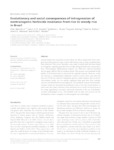Por favor, use este identificador para citar o enlazar este ítem:
http://www.alice.cnptia.embrapa.br/alice/handle/doc/1065797Registro completo de metadatos
| Campo DC | Valor | Lengua/Idioma |
|---|---|---|
| dc.contributor.author | MEROTTO JUNIOR, A. | pt_BR |
| dc.contributor.author | GOULART, I. C. G. dos R. | pt_BR |
| dc.contributor.author | NUNES, A. L. | pt_BR |
| dc.contributor.author | KALSING, A. | pt_BR |
| dc.contributor.author | MARKUS, C. | pt_BR |
| dc.contributor.author | MENEZES, V. G. | pt_BR |
| dc.contributor.author | WANDER, A. E. | pt_BR |
| dc.date.accessioned | 2017-03-02T11:11:11Z | pt_BR |
| dc.date.available | 2017-03-02T11:11:11Z | pt_BR |
| dc.date.created | 2017-03-02 | pt_BR |
| dc.date.issued | 2016 | pt_BR |
| dc.identifier.citation | Evolutionary Applications, v. 9, n. 7, p. 837-846, Aug. 2016. | pt_BR |
| dc.identifier.uri | http://www.alice.cnptia.embrapa.br/alice/handle/doc/1065797 | pt_BR |
| dc.description | Several studies have expressed concerns about the effects of gene flow from transgenic herbicide-resistant crops to their wild relatives, but no major problems have been observed. This review describes a case study in which what has been feared in transgenics regarding gene flow has actually changed biodiversity and people?s lives. Nontransgenic imidazolinone-resistant rice (IMI-rice) cultivars increased the rice grain yield by 50% in southern Brazil. This increase was beneficial for life quality of the farmers and also improved the regional economy. However, weedy rice resistant to imidazolinone herbicides started to evolve three years after the first use of IMI-rice cultivars. Population genetic studies indicate that the herbicide- resistant weedy rice was mainly originated from gene flow from resistant cultivars and distributed by seed migration. The problems related with herbicideresistant weedy rice increased the production costs of rice that forced farmers to sell or rent their land. Gene flow from cultivated rice to weedy rice has proven to be a large agricultural, economic, and social constraint in the use of herbicideresistant technologies in rice. This problem must be taken into account for the development of new transgenic or nontransgenic rice technologies. | pt_BR |
| dc.language.iso | eng | eng |
| dc.rights | openAccess | eng |
| dc.subject | Fluxo de genes | pt_BR |
| dc.subject | Clearfield TM | pt_BR |
| dc.subject | Fitness | pt_BR |
| dc.title | Evolutionary and social consequences of introgression of nontransgenic herbicide resistance from rice to weedy rice in Brazil. | pt_BR |
| dc.type | Artigo de periódico | pt_BR |
| dc.date.updated | 2017-03-02T11:11:11Z | pt_BR |
| dc.subject.thesagro | Arroz | pt_BR |
| dc.subject.thesagro | Herbicida | pt_BR |
| dc.subject.nalthesaurus | Red rice | pt_BR |
| dc.subject.nalthesaurus | Herbicide resistance | pt_BR |
| dc.subject.nalthesaurus | Outcrossing | pt_BR |
| dc.subject.nalthesaurus | Imazethapyr | pt_BR |
| dc.subject.nalthesaurus | Gene flow | pt_BR |
| dc.subject.nalthesaurus | Acetolactate synthase | pt_BR |
| riaa.ainfo.id | 1065797 | pt_BR |
| riaa.ainfo.lastupdate | 2017-03-02 | pt_BR |
| dc.identifier.doi | 10.1111/eva.12387 | pt_BR |
| dc.contributor.institution | Aldo Merotto Junior, UFRGS; IVES CLAYTON GOMES DOS REIS GOULART, CNPF; Anderson L. Nunes, IFRS; Augusto Kalsing, Dow AgroSciences; Catarine Markus, UFRGS; Valmir G. Menezes, IRGA; ALCIDO ELENOR WANDER, CNPAF. | pt_BR |
| Aparece en las colecciones: | Artigo em periódico indexado (CNPF)  | |
Ficheros en este ítem:
| Fichero | Descripción | Tamaño | Formato | |
|---|---|---|---|---|
| 2016IvesEAEvolutionary.pdf | 835.4 kB | Adobe PDF |  Visualizar/Abrir |









